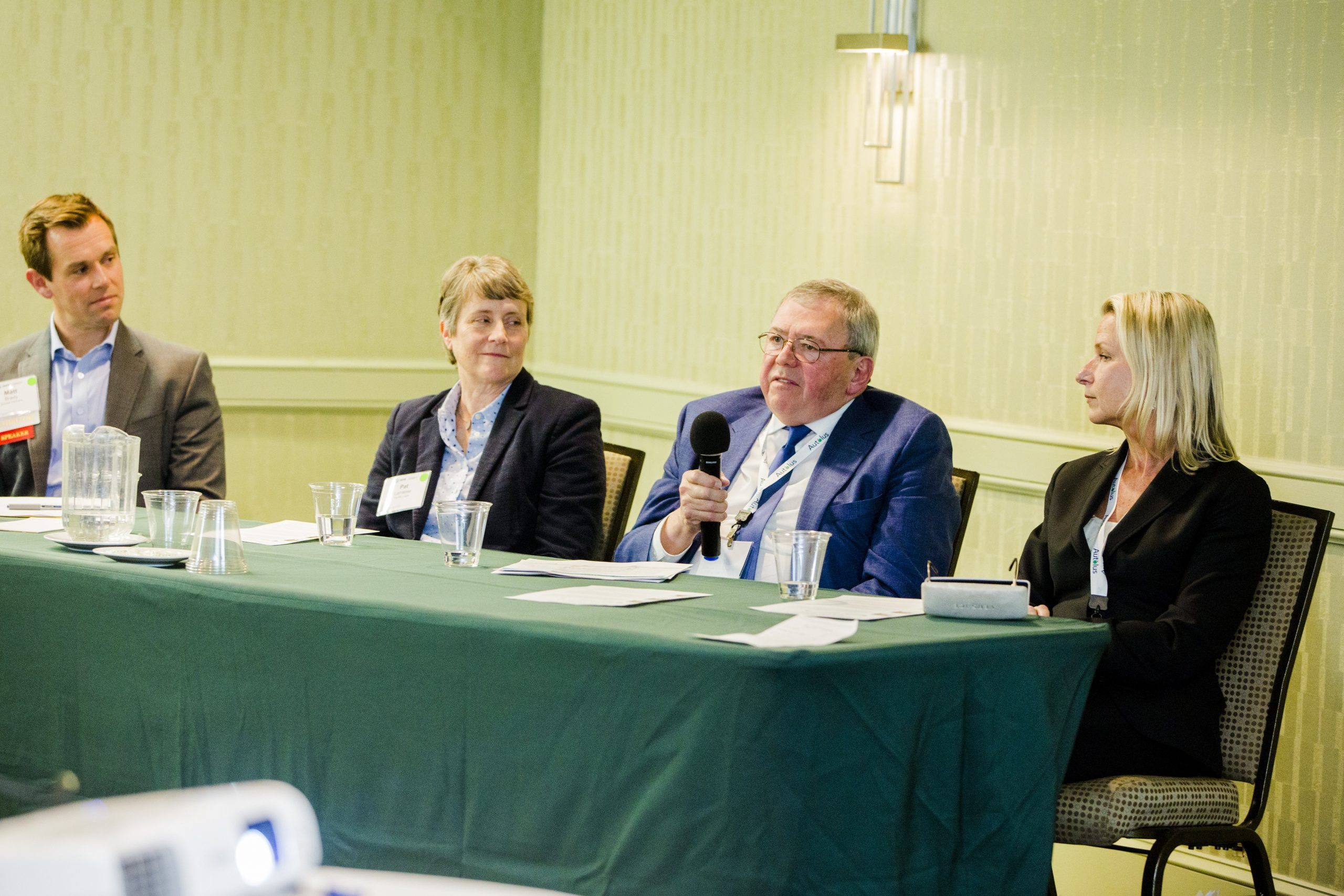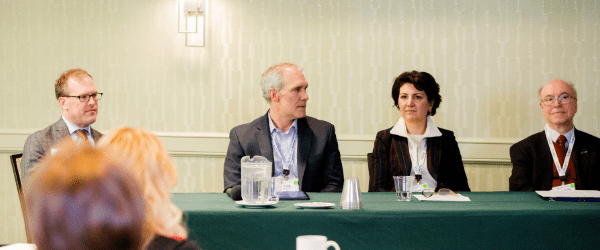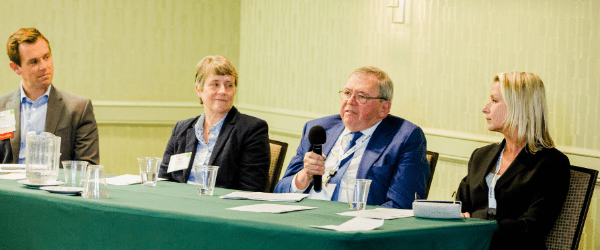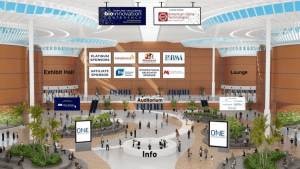
Leaders Discuss Top Priorities for Workforce & Infrastructure to Grow BioHealth Capital Region
April 3, 2019
Scientists, engineers, life science executives, academics, government officials and other constituents recently gathered to discuss the state of the BioHealth Capital Region (BHCR) at the annual Mid Atlantic Science & Technology (MAST) Showcase, hosted by the International Society for Pharmaceutical Engineering – Chesapeake Bay Area Chapter’s (ISPE-CBA).
Breakout sessions on talent/workforce development, single-use technology, the state of the market and bioprocessing sparked a day of robust discussion. The excitement, enthusiasm and a collaborative spirit buzzed across the showroom floor, with standing room only in the breakout rooms and during the keynote address by Autolus Therapeutics’ VP, Engineering & Supply Chain, Aaron Vernon.
What was all the excitement about?
Impending BHCR growth with approximately 2,000 new jobs (some suggest there might be even more to follow) and the challenge of managing this rapid growth via increased collaboration and stronger partnerships.
Leaders from the University of Maryland- Baltimore County (UMBC), GlaxoSmithKline (GSK), RegenxBIO and the Maryland Department of Commerce addressed this growth management challenge in a panel discussion entitled, “Recruiting and Developing Talent in the BioHealth Capital Region.” The panel was moderated by Chris Frew, CEO of Workforce Genetics, a consulting firm that helps life science companies accelerate growth through strategic employer branding and recruiting strategies.

All panelists cited strong workforce development programs and increased collaboration among universities, colleges, industry and the government as critical to creating a “rising tide” philosophy that uplifts the entire BHCR, not just a handful of organizations.
Shiva Fritsch, SVP Human Resources at RegenxBIO, and Craig Malzahn, VP at GSK and Site Director of the Rockville BioPharm site, stressed increased cooperation, even among perceived competitors, and more open communication as a pathway to reaching the BHCR’s top 3 by 2023 goal. Fritsch’s statement “We can’t get there by just recruiting each other’s employees all the time. We need to do more to collectively attract more talent to the region,” received unanimous agreement among the panel.
Malzahn discussed several things that GSK does to attract and develop talent, which is a top priority for his site that has over 200 open jobs to fill. Programs such as an industry-first Validation Apprenticeship program, a Future Leaders Program that rotates new hires through several departments to accelerate their development and employee resource groups that foster a culture of engagement and collaboration are key GSK talent programs. Virtual Reality training was even discussed as something that GSK is considering to speed up employee development.
The ISPE Chesapeake Bay Chapter is moving its own programs forward as well. Young Member Chair Dante Amatangelo of VaLogic announced the launch of the new statewide ISPE Maryland Student Chapter with a kick-off event planned for April 24th. The student chapter will serve an important role in curating early talent within the universities across the state while helping to connect student members with companies for training, internships and other job opportunities.
Internships in particular were cited as one of the most important components to graduating students who are trained and ready to work upon graduation. UMBC’s Vice Provost Antonio R. Moreira, PhD, cited statistics and highlighted some success stories from UMBC. Moreira also made it clear that his doors are open and he wants more collaboration with companies about ways to educate, train and better prepare their students for productive careers.

By moving away from a shorter term, tactical approach and embracing a 10-year time horizon, academic institutions, government entities and industry could build a sustainable workforce development and talent infrastructure that could benefit everyone.
One thing was clear from both panelists and the audience alike; people are ready for more than a lively and optimistic panel discussion: They are ready for action. Moreira might have captured the spirit of the panel best when he suggested that “…we all agree so let’s get this done.”
Some programs are already underway. Bret Schreiber, Senior Director, Office of BioHealth and Life Sciences, at the Maryland Department of Commerce shared some of the collaborative programs that the state has been involved with to help achieve these workforce goals, such as:
- The Kite-Hood Innovation Institute: Facilitated by the Department of Commerce, Hood College in Frederick is now working with Kite, a Gilead Company to create an innovation and training institute on campus that would align their education programs with Kite’s workforce needs. This includes industry-led curriculum development, hands-on training using industry-grade equipment, internships and even
part time jobs for faculty to work with Kite to better understand its training needs. - Bridges to Bio: This program recruits postdocs from Johns Hopkins University (JHU), The University of Maryland (UMD) and the National Institutes of Health (NIH) to experience a ‘day in the life of” work at various, local biotech companies, providing them exposure to the demands and expectations of careers in industry.
- GMP Center of Excellence: A GMP Center of Excellence training facility is in development with the UMD to be held at the Universities at Shady Grove Campus. The program is supported by the National Institute for Innovation in Manufacturing Biopharmaceuticals (NIIMBL), a nationwide collaborative to enhance America’s manufacturing innovation. The GMP Center of Excellence will be run by the renowned Biotech Research and Education Program (BREP).
The State of the Market
“The State of the Market” break out session, hosted by Judy Costello, Managing Director of Economic Development for BioHealth Innovation, Inc. (BHI) struck a similar chord about BHCR growth and change management. The panel included Matt Brady, SVP of Scheer Partners; Margot Connor, CEO of Rooster Bio, Inc.; Patricia Larrabee, MS, President of Facility Logix and Marco A. Chacón,

The panelists engaged in passionate dialog about growth, confirming the 2,000 new jobs coming to the region are not just hype; it’s a legitimate projection, supported by job board postings and various economic models. Some even noted that the 2,000 jobs might just be the tip of the iceberg.
Connor of RoosterBio spoke with infectious enthusiasm about what a great time it is to be a growing company in the fertile BHCR ecosystem. She strongly emphasized the need for the BHCR to pull together during this time of rapid change.
How the BHCR environment is changing and what regional adjustments need to be made was also top-of-mind for the panel. Maryland can differentiate itself from major life sciences hubs like Boston by leveraging its ascending status as a global manufacturing center of excellence, suggested Chacón. How the BHCR chooses to position itself against competing life science clusters will not only be critical to generating greater investment interest, but will also help attract and retain top industry talent.
This is just part of the story, however.
While the BHCR is poised for significant growth, the very nature of regional manufacturing is being transformed by the rise of personalized medicine across the region, which includes a host of new and growing regenerative medicine, cell therapy and gene therapy companies. How the region adjusts to this paradigm shift–or, for that matter, does not–is a big unknown and an even bigger, ongoing challenge. ISPE’s MAST sessions on bioprocessing and single-use technology adoption at larger life science organizations drove home the message that regional manufacturing is evolving.
Companies like Rooster Bio, Autolus and RegenxBio, to name just a few growing personalized medicine organizations in the area, are changing the manufacturing and supply chain needs of the BHCR. Cell and gene therapy companies have different (and still developing) manufacturing and supply chain needs (See Autolus Keynote for more on this topic).
Infrastructure development to better support personalized medicine manufacturing and the new supply chain pathways is essential. Rooster Bio’s Connor shared that when the company grew out of the Frederick Innovation and Technology Center (FITCI) the organization had a difficult time finding the lab space it needed. What’s more, Brady of Scheer Partners, which is a commercial real estate company with a life science focus, cited a general lack of commercial space and rising rents as detrimental to life science industry growth in general.

Lab space, especially with the “pivotability” required by personalized medicine manufacturing, is difficult to find and commercial building owners are largely unaware that their spaces can be fitted out for flexible lab space. The perception is that converting commercial space to lab/office use is expensive, time consuming and less profitable. But this is based on an old biotech manufacturing view that all labs require large, complex bioreactors and intricate piping and ventilation systems. That’s simply not the case with personalized medicine, and Brady stressed the need to educate the commercial real estate market and build awareness that converting space into personalized medicine labs is a less costly and complex venture than it’s perceived to be.
Brady noted that Scheer Partners is seeing slow but steady awareness building in this area with new lab/office projects being developed at 700 (Supernus Pharmaceuticals) and 704 Quince Orchard Road, at 9950 and 9800 Medical Center Drive (Autolus and RegenxBIO, respectively) and even on Wisconsin Avenue near the National Institutes of Health (NIH). More work needs to be done, suggested Brady, to build out the infrastructure to help the personalized medicine industry thrive in the BHCR.
Speed to market is critical for organizations, stated Larrabee of Facility Logixs–these companies can’t wait a 18 months for a ground-up build. Stronger partnerships with non-life science commercial spaces to retrofit for flex lab space is an imperative, she added.
Panelists also touched on workforce development efforts targeting personalized-medicine specific talent, stronger government collaboration and an improved venture capital environment as other significant regional needs.
Clearly, the state of the BHCR is strong and getting stronger, but it is not without significant challenges that will require multidisciplinary, cross-functional collaboration to overcome.
The scale of this year’s MAST Showcase was emblematic of overall market growth. Conference organizers Lynda Duffy, ISPE Chapter Manager, and Caroline Cappo of Whiting Turner, wanted this event to truly support the needs of its members. The event attracted over 600 attendee registrations and 85 showcasing companies. It was the largest annual event in the chapter’s history.
The energy, excitement and cooperative mindset was evident in the education sessions, in small, private conversations on the vendor showcase floor and at the event’s after party. ISPE’s MAST 2019 overarching theme is best expressed as a “rising tide lifts all boats” esprit de corps, where the whole of the BHCR becomes greater than the sum of its parts.

- About the Author
- Latest Posts
Steve brings nearly twenty years of experience in marketing and content creation to the WorkForce Genetics team. He loves writing engaging content and working with partners, companies, and individuals to share their unique stories and showcase their work. Steve holds a BA in English from Providence College and an MA in American Literature from Montclair State University. He lives in Frederick, Maryland with his wife, two sons, and the family dog.





